In recent years, therapy has started to look a little different. What used to be quiet rooms and repetitive exercises has now, in some cases, transformed into something far more engaging: games. Yes, video-game-like systems, points, rewards, and virtual avatars are now part of therapy sessions. This shift has led to one big question—can gamification be as effective as, or even more effective than, traditional therapy?
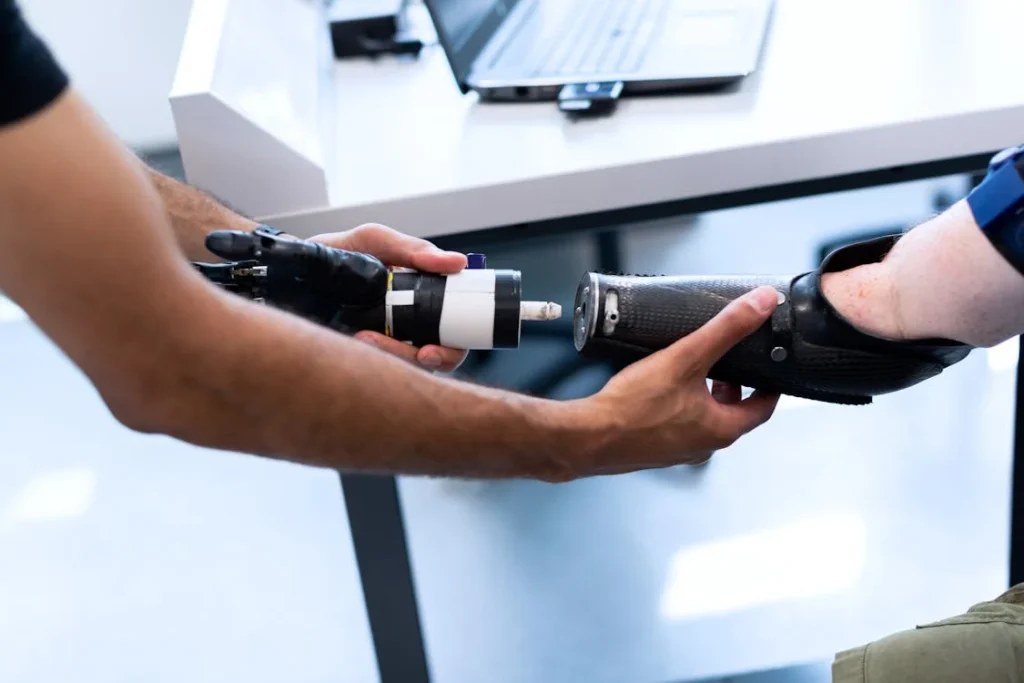
What Is Traditional Therapy Really About?
Understanding the Foundations of Traditional Rehabilitation
Traditional therapy has been around for decades. It’s the tried-and-tested method that helps people recover from surgeries, injuries, and other physical limitations. In the case of prosthetic users, it plays a huge role in building strength, balance, and coordination.
It’s usually guided by a physiotherapist, occupational therapist, or both. The sessions are structured and clinical. You’ll find exercise mats, therapy balls, resistance bands, and sometimes even parallel bars. The setting is usually a hospital, a clinic, or a rehabilitation center. Everything about it feels serious and purposeful—because it is.
The exercises you perform in traditional therapy are targeted. They’re designed to restore lost functions or teach new ways of moving. For example, someone who’s recently been fitted with a lower-limb prosthesis may work on standing balance, core strength, and gait. The therapist observes carefully, corrects mistakes, and encourages good form. Over time, muscle memory is built, and confidence improves.
But here’s the catch: traditional therapy can feel repetitive. There’s a certain monotony to doing the same drills over and over again. The environment isn’t always exciting, and for many patients—especially young ones or those going through long-term rehab—it can get boring. Motivation dips, and that can slow down progress.
The Human Element: Therapist-Patient Bond
One of the strengths of traditional therapy is the relationship between the therapist and the patient. It’s personal. A good therapist doesn’t just instruct; they support emotionally. They understand setbacks and adapt plans. This connection creates a layer of trust, which can be powerful in recovery. Patients are more likely to open up about their challenges and stick to their plans.
That said, therapists are also human. They can only see so many patients in a day. Progress tracking is often manual, and in some areas, the shortage of skilled professionals can create barriers to consistent care. In places like India’s smaller cities or rural pockets, access to regular physical therapy might not be as easy as it sounds.
How It Helps in Prosthetic Use
For someone with a new prosthetic limb, traditional therapy is essential at the start. Learning to use a prosthesis isn’t just about attaching it and walking. It’s about retraining the brain and body to work in sync. The stump needs to be strengthened. Balance needs to be regained. In upper-limb prostheses, users have to practice gripping, pinching, and manipulating objects—all using a device that doesn’t feel like their real hand.
Therapists create specific regimens. They might use weighted objects, therapy putty, or resistance equipment to train the residual limb. They also teach how to care for the skin, manage pressure points, and handle the emotional challenges that come with limb loss.
So, in short: traditional therapy is thorough, personal, and backed by years of research. But is it enough to keep a patient coming back, especially when progress is slow?
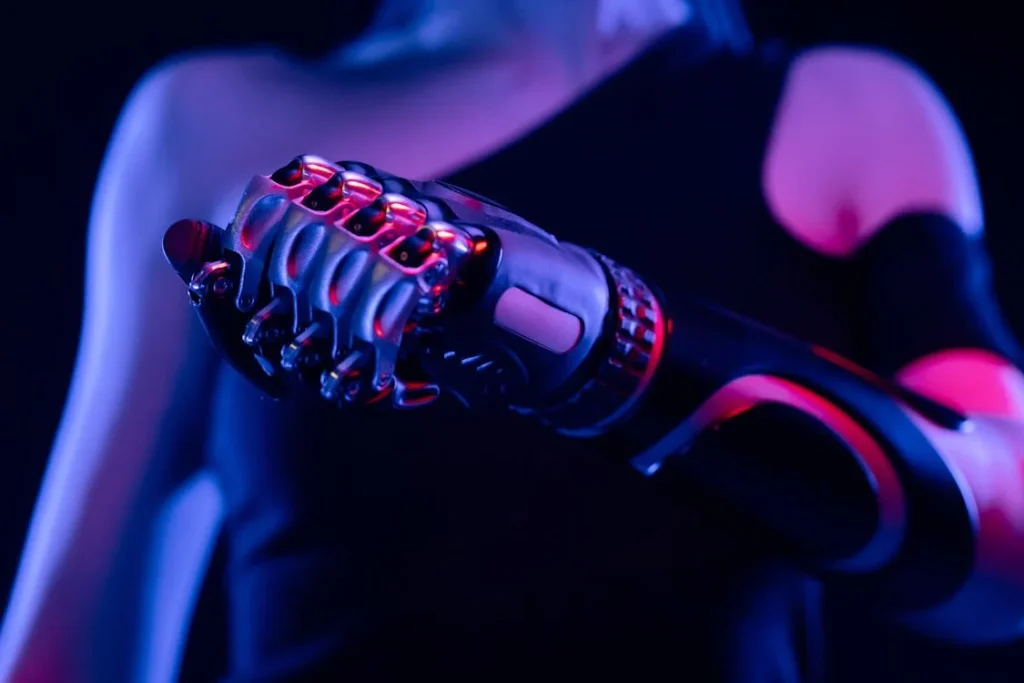
Gamification and How It Works in Therapy
What Exactly Is Gamification?
Gamification is not about playing random games—it’s about using game-like elements in serious settings to keep people motivated. Think of it as turning therapy into a mission, a challenge, or even a bit of fun. Instead of being asked to repeat a movement 10 times on a dull mat, imagine a screen in front of you. You’re navigating a virtual character through a maze by flexing your arm muscles. Every successful movement earns you points. You hit a target—your screen celebrates. You miss—it gives you gentle feedback. That’s gamification in action.
This method has gained a lot of attention in rehab, especially in recent years. It’s being used for stroke survivors, spinal cord injury patients, and yes, even for people learning to use prosthetics. The core idea is simple: people stick with therapy longer and push harder when they’re enjoying it. That’s the power of play.
Why It Works: The Brain Loves Rewards
Gamification taps into something deeply human: the desire to achieve. Whether it’s earning a badge, climbing a leaderboard, or beating your last score, it gives you small rewards for small wins. Each reward triggers a positive response in the brain. This release of dopamine—a feel-good chemical—makes the brain want more. So, even though you’re technically doing “therapy,” it doesn’t feel like a chore. It feels like progress.
For someone using a prosthetic arm, this might mean learning how to control the grip by guiding a digital hand on screen to pick up and place virtual objects. The feedback is instant. Did you squeeze too hard? Not hard enough? The system tells you right away and lets you try again.
With lower-limb prosthetics, there are programs that track walking patterns. You might walk across a pressure-sensitive mat, and a screen shows you how evenly you’re stepping. Maybe there’s a virtual coach cheering you on. Each session becomes a mini-game that shows how far you’ve come—and how much better you’re getting.
Examples in Real Life Rehab Settings
Around the world, clinics and startups are starting to combine virtual reality (VR), motion sensors, and artificial intelligence (AI) to create smart rehab systems. A user might wear a headset and find themselves inside a virtual garden. They can water plants, pick apples, or play with a dog—all by moving their limb in certain ways. Each movement is carefully chosen by a rehab expert to target specific muscle groups and motor skills.
In India, some advanced prosthetic centers are beginning to adopt similar tools. At Robobionics, for instance, we’ve seen firsthand how even basic gamified systems—using simple screens and sensors—can make a big difference. Patients who were hesitant or nervous suddenly become curious and more open to trying things. The fear of failure lowers because the environment feels safe and non-judgmental.
The Technology Behind the Fun
Most gamified therapy setups use a few key tools. Sensors track movement. These could be attached to the body or built into the prosthetic. The data from these sensors is then processed by a computer, which controls the game’s visuals and sound. Some setups use cameras to track body motion, similar to how gesture-control systems in gaming consoles work.
Then there’s software. It translates real movements into digital ones. Some systems come with dozens of mini-games tailored to different therapy needs—grip strength, balance, reaction time, coordination. What makes this powerful is that the difficulty can adjust automatically. If you’re doing well, the game gets a little harder. If you’re struggling, it slows down or guides you more gently.
And here’s the best part: all the data is stored. That means therapists and patients can look back and see actual progress in numbers and visuals. It’s no longer just “I feel better”—it’s “I completed 20 levels this month and improved my speed by 30%.” That kind of evidence boosts confidence and trust in the process.
Gamification and Children With Prosthetics
One area where gamification really shines is in pediatric rehab. Children, especially those born with limb differences or those who’ve had amputations early in life, often struggle with traditional therapy. It feels restrictive, clinical, and—let’s face it—boring. But introduce a colorful game where a lion needs their help to build a treehouse, and suddenly they’re reaching, lifting, and problem-solving without even realizing they’re doing therapy.
At Robobionics, we’re deeply invested in the early stages of prosthetic training, and gamified tools have been game-changers (no pun intended) for younger users. They feel empowered, curious, and more in control of their journey.
Emotional Engagement and Consistency
Gamification doesn’t just help physically. It supports emotional healing too. People using prosthetics often face frustration, self-doubt, and isolation. A fun, immersive system provides distraction, encouragement, and a sense of achievement. When a task is fun, you’re more likely to return to it. That’s key in rehabilitation, where consistency is everything.
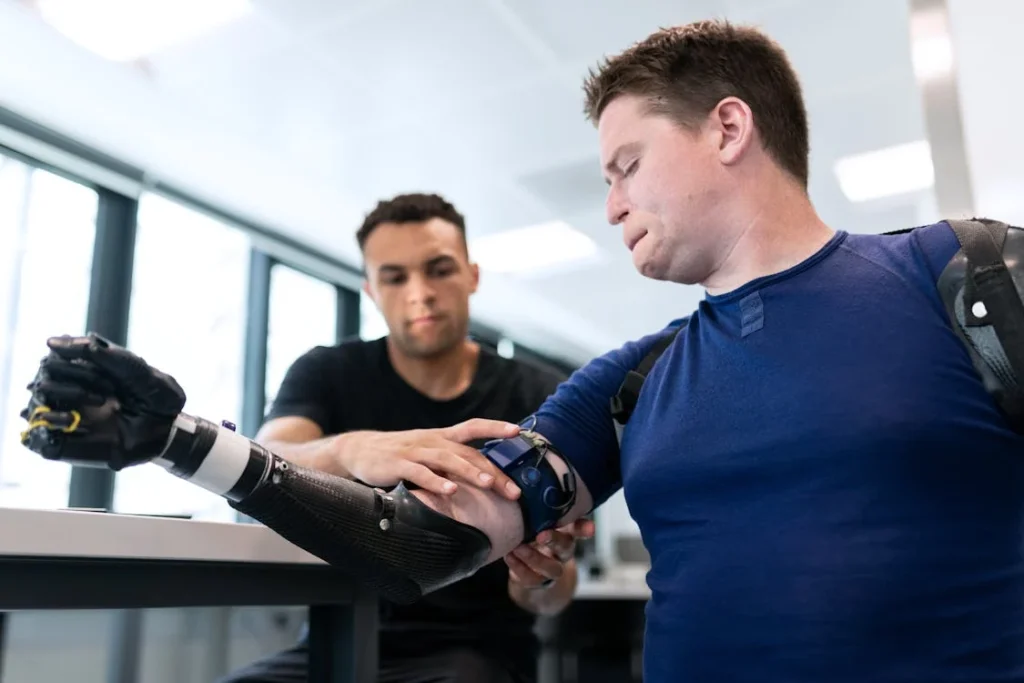
Comparing Outcomes: Which Approach Leads to Better Results?
Not Just a Matter of Preference—It’s About Performance
Now that we understand both gamification and traditional therapy, the big question is: which one actually works better?
The answer isn’t black and white. Both approaches have strengths, and their effectiveness often depends on the individual. But if we look closely at the data and real-world results, we begin to see clear patterns. It’s not just about how fun therapy is—it’s about how much it helps someone move, grow, and feel like themselves again.
In clinical settings, researchers have started comparing how people perform when using gamified rehab tools versus traditional methods. Many studies show that people who use gamified systems often stick with therapy longer. They’re less likely to skip sessions, more likely to complete their programs, and they tend to push themselves harder—without needing to be told.
This matters. In rehabilitation, consistency is everything. If someone does their therapy just a few times a week, their progress will be slower than someone who stays fully engaged. Gamification increases that engagement. It turns rehab from something people “have to do” into something they “want to do.”
Real-Life Improvements: Physical and Mental Gains
Physically, gamification has shown impressive results. Users improve their coordination, speed, and reaction times—often faster than they would through standard exercises. For example, someone training with a myoelectric arm might need to practice specific grip patterns. In a game setting, this could mean picking up virtual coins or controlling a drone. The user repeats the same muscle actions they’d practice in traditional therapy, but now they’re reacting to a game environment, which sharpens focus and builds better reflexes.
In traditional therapy, these tasks might involve simply opening and closing the hand or picking up cones. While useful, the context isn’t always stimulating. Gamified exercises demand quick thinking, faster feedback, and constant adjustment—which means they train the brain and the body at the same time.
Mentally, the boost is just as big. Patients using gamified tools report feeling more in control of their recovery. They enjoy seeing real-time feedback. They like knowing when they’ve hit a milestone. And most importantly, they don’t feel like they’re “behind.” Everyone progresses at their own pace in the game world, which creates a non-competitive but motivational space.
Traditional Therapy Still Holds an Edge in Certain Areas
That said, traditional therapy isn’t going anywhere—and it shouldn’t. It still plays a crucial role, especially in the early stages of rehabilitation. Right after surgery or amputation, patients need close supervision. Their movements are limited, pain levels are high, and emotional distress can be overwhelming. In these moments, a human touch is irreplaceable.
A therapist can read body language, adjust exercises in real time, and offer comfort that no screen or game can. They also teach foundational skills like posture correction, weight transfer, and breathing control—things that gamified systems don’t always cover in depth.
Moreover, in complex cases where someone has additional medical issues—like diabetes, arthritis, or nerve damage—therapy needs a custom approach. It’s not just about repetition. It’s about understanding the full picture of a patient’s health. That’s where experienced therapists truly shine.
The Hybrid Model: Getting the Best of Both Worlds
Rather than choosing one over the other, the best results often come from blending gamification with traditional therapy. This hybrid model is already being used in top rehabilitation centers. Here’s how it works: the therapist conducts an initial assessment, sets goals, and teaches the patient correct form. Once the patient is ready, gamified systems are introduced for home-based or supplementary practice.
This method allows patients to continue therapy on their own terms, in their own space, while still checking in regularly with their therapist. It keeps motivation high without losing the personal care that’s so important. It also means therapy doesn’t stop when the patient leaves the clinic.
At Robobionics, we’ve begun integrating this approach. After our prosthetic users finish basic training under the guidance of our clinical team, we offer them access to gamified follow-up tools. This empowers them to keep practicing at home while staying connected to our specialists through digital tracking. The results? More confidence, better movement, and fewer dropouts from rehab programs.
Who Benefits the Most from Gamification?
While everyone can benefit from an engaging approach, there are specific groups that tend to do even better with gamified therapy. Children, for example, respond enthusiastically to colorful graphics, story-driven missions, and interactive environments. They don’t think of it as therapy at all—they think it’s fun. That joy carries them through what could have been a frustrating process.
Teens and young adults, too, enjoy the tech-driven side of gamification. They’re used to apps, screens, and video games. Adding this layer to their rehab journey makes the process feel more in tune with their lifestyle.
Older adults might be slower to adapt, but many still find value in the feedback and structure these systems offer. With some training and the right guidance, even seniors with prosthetics can enjoy the rhythm of gamified rehab. Plus, some systems are now built with age-friendly interfaces—larger text, slower speeds, and simplified controls.
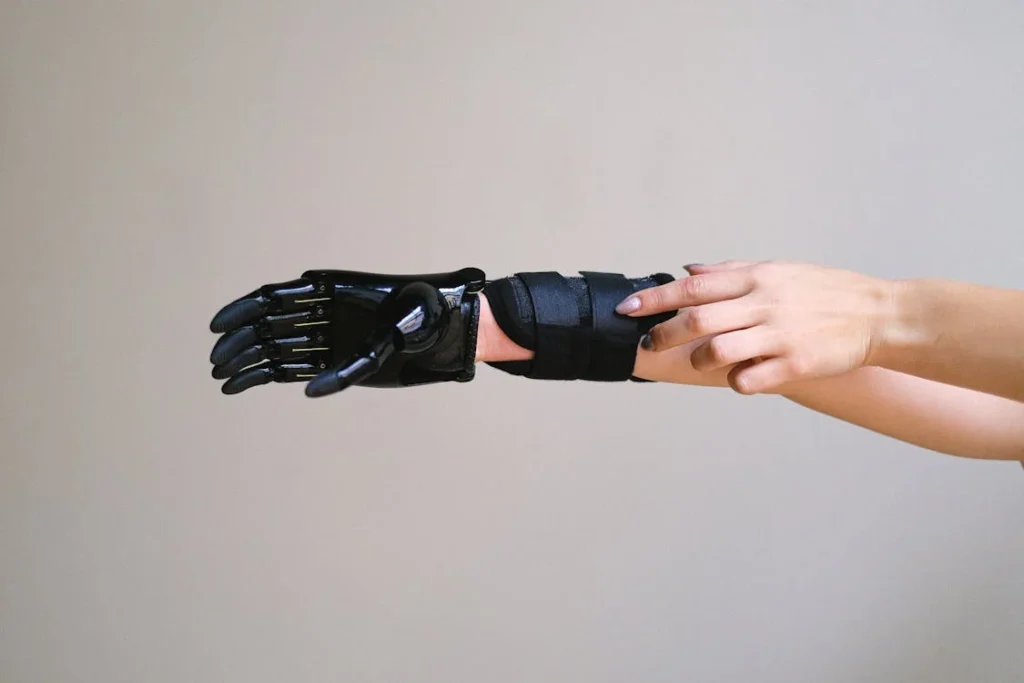
Challenges and Considerations: Where Each Approach Falls Short
No Method Is Perfect
While both gamification and traditional therapy bring unique advantages to rehabilitation, especially for prosthetic users, they also come with certain limitations. It’s important to understand these challenges—not just to make better choices, but to manage expectations. Because when people expect therapy to “just work,” any delay or setback can feel like failure. And that’s never fair.
Let’s dive into where each approach can sometimes fall short and what you can do to work around those issues.
Where Traditional Therapy Stumbles
Repetition Without Motivation
One of the most common complaints about traditional therapy is boredom. Exercises are often repetitive. You might be asked to do the same move—like squeezing a ball or standing on one leg—over and over. The first few times, it feels productive. But after a while, it can start to feel pointless, especially if you’re not seeing fast results.
That’s where motivation starts to dip. And once that happens, consistency takes a hit.
Lack of Instant Feedback
Another issue is the pace of feedback. In traditional therapy, feedback mostly comes from the therapist. But they might only see you a few times a week. That means small errors in movement can go unnoticed. For example, if you’re not engaging the right muscle group while walking with a prosthetic leg, you might continue practicing incorrectly until your next appointment. This slows progress and can even cause bad habits.
Accessibility Barriers in India
In many parts of India, access to quality rehabilitation is still limited. Physical therapy centers may be far away, expensive, or under-equipped. In rural areas, a trained therapist may not be available at all. This makes it harder for patients to receive regular care. Even in cities, appointments may be brief and hurried due to high patient loads.
At Robobionics, we’ve seen cases where patients travel hours just for one therapy session. It’s not sustainable, especially when rehab is supposed to be ongoing.
Emotional Disconnect
Sometimes, traditional therapy feels too clinical. Especially for young or emotionally sensitive patients, the sterile environment and strict routines can make therapy feel cold. There’s often little room for self-expression or creativity in the process. This can lead to disengagement, especially in long-term rehabilitation programs.
Where Gamification Misses the Mark
Not Always Customised for Complex Cases
Gamified therapy systems often use preset programs. While many are smart enough to adapt to a user’s performance level, they may not always account for medical complications or very specific patient needs. For example, someone with a skin graft or phantom limb pain might require modified therapy routines that the software isn’t designed to handle.
Gamification works best when the user has enough range of motion and cognitive capacity to interact with the system. But if someone has very limited mobility or additional health conditions, the technology might not respond well—or at all.
Cost and Technology Gaps
While gamified rehab can be highly effective, it often comes with a price. Devices, sensors, software licenses, and even internet access can be barriers. In low-income communities or areas with poor connectivity, these tools might be completely out of reach. For someone who can barely afford their prosthetic, adding a smart training kit might not be practical.
This is something we’re working hard to solve at Robobionics. We’re investing in low-cost, offline-capable systems that can run on basic hardware, making gamified rehab more accessible to Indian patients who deserve better tools.
Too Much Screen Time, Not Enough Real-Life Context
One strange irony of gamification is that it sometimes makes users good at “winning the game” but not necessarily at performing real-life tasks. Someone might learn how to squeeze a digital object perfectly on-screen, but still struggle to hold a real spoon or button a shirt.
That’s because the virtual environment, no matter how well-designed, can’t fully recreate the challenges of the physical world. Real objects have textures, weights, resistance, and unpredictability. So while gamification is a great supplement, it cannot replace hands-on training with real-world tasks.
Emotional Dependency on “Winning”
While games are fun, they can also be frustrating—especially if someone hits a level they can’t pass. Some users may start to feel defeated if they don’t “score” well. This emotional rollercoaster can demotivate certain patients, especially if they tie their self-worth to the game’s feedback.
That’s why it’s important to strike a balance. Celebrate effort, not just results. Make sure the therapy system is encouraging, not punishing.
Safety Concerns in Both Approaches
Let’s not forget safety. In traditional therapy, a therapist is usually there to guide, correct, and assist. But in gamified therapy—especially home-based versions—the user is often alone. Without proper instruction, they might do an exercise the wrong way, strain a muscle, or worse, fall and injure themselves. That’s why both approaches require smart supervision and clear instructions, no matter how “easy” a system looks.
What This Means for Patients and Caregivers
The takeaway? Neither method is perfect. But when we understand the limitations, we can work smarter.
Patients and caregivers should always:
- Set realistic goals.
- Combine approaches when possible.
- Monitor for signs of fatigue, emotional distress, or physical strain.
- Keep communication open with the rehab team.
- Use gamification to support, not replace, real-world tasks.
At Robobionics, we encourage our patients to talk to us openly about what’s working and what’s not. Whether they’re in a city with full access to high-tech rehab, or in a small town with just a basic prosthetic and a smartphone, we aim to support every part of the journey.
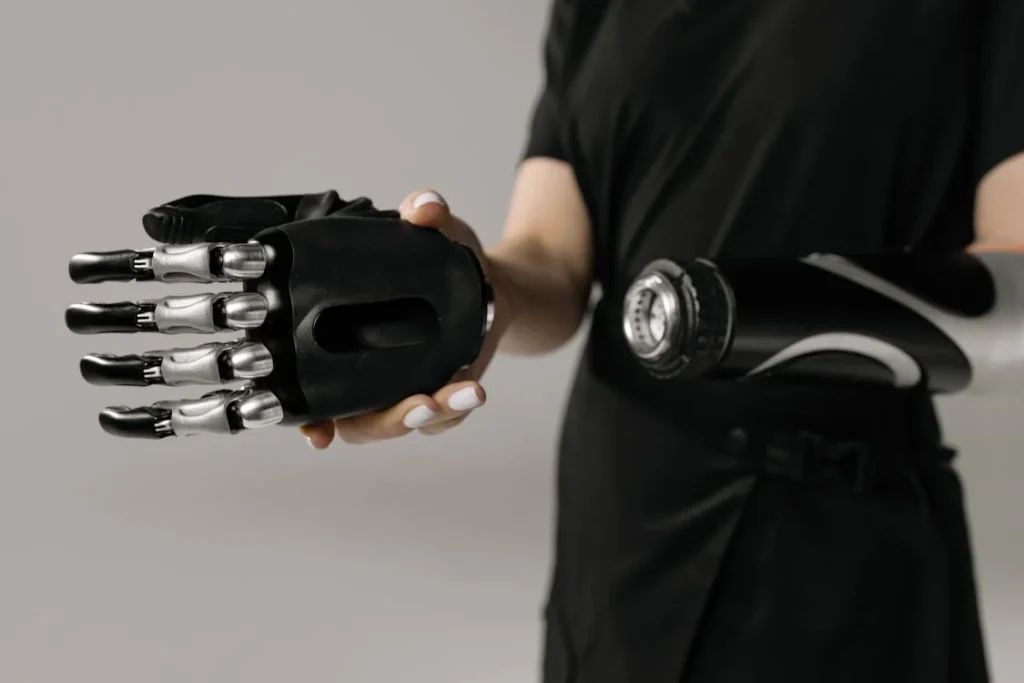
The Role of Motivation and Identity in Rehabilitation Success
Why Identity Shapes Recovery
Rehabilitation after limb loss isn’t just a physical journey—it’s a deeply personal one. Whether you’re learning to walk again with a prosthetic leg or figuring out how to grip a cup with a bionic hand, what you’re really doing is rebuilding a sense of self. That’s where motivation and identity play an enormous role.
Imagine this: someone who has lost a limb might feel like their body has betrayed them. They may feel incomplete, unsure, even ashamed. If the rehab process feels like punishment—repetitive drills, sterile environments, long periods with little visible progress—then they’re less likely to engage with it. But if therapy, through either traditional or gamified methods, helps them feel like themselves again, they’re more likely to commit to it wholeheartedly.
This is where gamification can shine. By turning therapy into something playful and empowering, it can help patients connect with a new version of their identity. They’re no longer just “a person who lost a limb”—they’re “someone improving their scores,” “beating levels,” or “helping a character in a game.” This shift in mindset isn’t small. It helps people move from victimhood to ownership.
Traditional therapy, on the other hand, reinforces identity in a different way. It reminds patients of their strength and discipline. With the constant encouragement of a therapist, patients often reconnect with the belief that their body is capable, resilient, and worthy of care. A therapist might say, “You did great today,” or “You’re walking better than you think,”—and these words carry weight. They’re real, personal, human.
Motivation: The Invisible Driver
Let’s talk about motivation. You can’t see it or measure it, but it’s often the biggest driver of successful outcomes. Two people with the same injury and the same prosthetic might have completely different results, depending on how motivated they are.
Gamified therapy creates motivation through rewards, progress bars, and fun. The more you engage, the more you unlock. It satisfies the human urge for accomplishment, and that keeps people coming back. But here’s the key: this type of motivation is often external. It’s driven by game mechanics. If the system becomes stale, or the person “finishes” the game, the motivation might disappear.
That’s why it’s important for gamified platforms to evolve continuously. They need new levels, changing challenges, and meaningful feedback to keep patients invested.
Traditional therapy builds intrinsic motivation—motivation that comes from within. When a therapist celebrates your smallest improvement or helps you overcome a mental block, you start believing in yourself. This kind of motivation lasts longer, even when progress slows down.
At Robobionics, we see the best results when both kinds of motivation are in play. A patient uses a gamified grip training tool at home, but still checks in with our therapist weekly. The therapist talks about progress, reassures them when they’re stuck, and helps set goals beyond the game. This balance builds both confidence and momentum.
Cultural Identity Matters Too
In India, the idea of therapy, disability, and even prosthetic use can carry strong cultural and emotional weight. Some people hide their prosthesis out of fear of judgment. Others refuse to attend physical therapy in public clinics because of shame or stigma. In such cases, the emotional burden is heavier than the physical one.
Gamified tools, especially those used privately at home, can offer a judgment-free space. They allow patients to explore and train without feeling watched or judged. This privacy can make all the difference in encouraging someone to begin therapy.
On the flip side, traditional therapy, when done in a supportive and respectful environment, can normalize prosthetic use. When patients see others like them in the clinic or engage in group therapy, they begin to realize they’re not alone. That too is a powerful identity shift—from “I’m broken” to “I’m part of a community.”
How Robobionics Approaches Motivation and Identity
At Robobionics, we believe therapy should always align with a patient’s goals—not just in terms of movement, but also self-perception. We ask questions like:
- What do you want your life to look like six months from now?
- How do you see yourself using your prosthesis—in private, in public, at work?
- What would make therapy feel more like your journey and less like a to-do list?
Our systems are designed to respond to those answers. Some patients want a quiet, focused routine with minimal tech. Others want to explore high-tech tools that make them feel futuristic and powerful. Some want support groups; others prefer solo paths.
There’s no one-size-fits-all when it comes to identity. And the more personalized the rehab journey, the better the outcomes—physically and emotionally.

The Role of Data and Personalization in Shaping Modern Rehabilitation
Why Data Is Becoming the Heart of Therapy
Rehabilitation is evolving—quietly but powerfully—thanks to data. Behind every exercise, every movement, and every game played during therapy, there’s a growing treasure of information. When used correctly, this data doesn’t just tell us what happened. It tells us what should happen next. And that’s a game-changer, especially for prosthetic users whose needs and progress vary so widely.
In traditional therapy, a therapist observes, takes notes, and adjusts routines based on experience and patient feedback. This is deeply personal and human—but also limited by time and memory. The therapist can’t track every micro-movement, every hesitation, or every time the patient favored one side over the other. Often, adjustments come after visible problems arise.
Gamified systems flip that script. From the first session, they start collecting data—how many times a muscle was activated, how long it took to complete a movement, how accurate each motion was, how often the patient paused. The system stores every detail, building a rich profile over time.
This makes it possible to track progress with precision. Did your reaction time improve by 12% this week? Are you gripping too hard when you pick up objects with your prosthetic hand? Are you walking longer distances before fatigue kicks in? The system knows—and it can adapt.
Personalization: Beyond the Standard Program
Personalization in therapy used to mean small tweaks to a printed exercise sheet. Now, it can mean having an AI-powered system that customizes your therapy based on your own daily metrics. If you’re progressing fast, the difficulty ramps up. If you’re struggling, it slows down, gives hints, or repeats simpler tasks until you’re ready to move on.
This dynamic tailoring isn’t just more effective—it feels more humane. It says, “This therapy is made for you,” not just “This is what everyone does.”
At Robobionics, we’re working on gamified platforms that do exactly this. One of our upcoming tools adjusts grip strength exercises based on the real-time fatigue detected through EMG signals from the user’s stump. If a user starts tiring, the tool reduces intensity but increases engagement through different types of tasks—like coordination-based challenges instead of power drills. The experience remains productive without becoming overwhelming.
Traditional therapy is also benefiting from digital personalization. More clinics now use wearable trackers, mobile apps, and digital progress logs to help therapists make better decisions. The therapist might notice, from a weekly report, that a patient’s walking symmetry has slightly worsened. Instead of waiting for the patient to complain of discomfort, they adjust the plan immediately.
Predictive Therapy: The Next Frontier
The magic doesn’t stop at personalization. With enough data, rehab systems can start to predict outcomes. This is called predictive therapy. By analyzing trends from thousands of patients, the system might say, “Patients with your profile tend to hit a plateau around week six—let’s introduce a new technique to keep you going.” Or, “People with your gait pattern often develop back strain—let’s add exercises to protect your spine early on.”
It’s not just smart—it’s proactive. And that kind of foresight is especially valuable in prosthetic rehab, where minor imbalances can lead to long-term complications.
For example, let’s say a patient is training with a below-the-knee prosthesis. The system notices they’re putting more weight on the sound leg, especially when turning. It alerts the therapist—or the patient directly—and recommends balance drills that target the weaker side. This kind of real-time coaching, even at home, prevents small issues from snowballing into major setbacks.
Privacy and Ethics: The Hidden Challenge of Data-Driven Therapy
As exciting as data-driven therapy is, it also brings up an important concern—privacy. The more data these systems collect, the more responsibility they have to protect it. A patient’s physical movements, therapy history, and health patterns are sensitive. If this data is ever misused or leaked, the consequences can be serious.
This is why Robobionics takes privacy seriously. Our platforms are built with end-to-end encryption, secure storage protocols, and full patient control over their data. Nothing is shared with third parties unless the patient gives clear consent.
We also believe that data should empower the patient, not just the system. That’s why our interfaces are designed to show users their own progress in simple, visual ways. They can track how far they’ve come, what their goals are, and what’s next—without needing to interpret complicated charts or numbers.
Data as a Motivational Tool
Here’s something powerful: when patients can see their improvement, they’re more likely to keep going. Data gives shape to the invisible progress we often overlook. Maybe your walking distance has increased by 500 steps a day. Maybe your grip strength improved by 8% this month. Maybe you’re completing exercises in 30% less time than when you started. Seeing this growth—not just feeling it—can be deeply motivating.
And in therapy, where progress is often slow and scattered, that little boost can make a big difference.
Conclusion
There’s no single winner in the debate between gamification and traditional therapy—because each shines in different ways. Traditional therapy offers human connection, emotional support, and expert intuition. Gamification brings energy, precision, and motivation through interactive feedback and data-driven insights. For prosthetic users, especially in a diverse country like India, the best path forward is often a blend of both.
At Robobionics, we believe rehabilitation should be personal, engaging, and accessible. Whether it’s a child learning to grip with a bionic hand or an adult mastering balance with a new leg, the right combination of approaches makes recovery more sustainable—and more human.
In the end, the real goal isn’t just better therapy. It’s better lives. And that starts with giving every person the tools, guidance, and confidence they need to rebuild on their terms.



